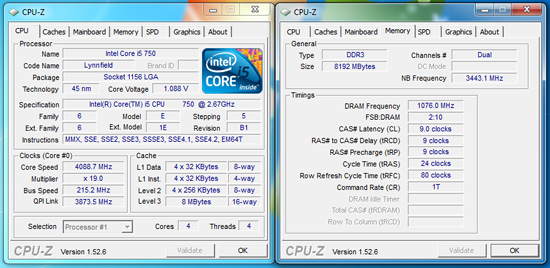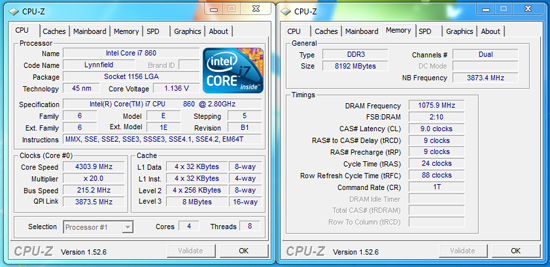Biostar TPower i55 – Super Middle Weight Contender
by Rajinder Gill on November 25, 2009 12:00 PM EST- Posted in
- Motherboards
Overclocking
The TPower i55 offers an excellent overclocking experience. Some additional BIOS tuning to improve memory performance would make this a great motherboard for most enthusiasts.
Core i5/750 8GB Results

Our maximum stable overclock on air-cooling with the Core i5/750 resulted in a 4.1GHz clock speed at a respectable 215MHz Bclk with a variety of 8GB DDR3-2000+ kits. The primary voltages settings were 1.3625V VCore, 1.35V VTT, 1.80V PLL, and 1.66V VDimm. We ran the board with Load Line Calibration enabled for stability due to the Dynamic VID setup on this board. This meant setting our voltage manually to 1.360V resulted in 1.368V readings under load and 1.088V at idle. We never encountered any problems with DVID, except for slightly lower benchmark scores as the system would generally take to ramp voltages before hitting maximum CPU core speeds.
We could run our memory at DDR3-2152 with 8GB loaded and the i5/750 on 1.66V VDimm. We scaled back to DDR3-1721 at C7 timings which offered the same performance, if not better, than DDR3-2152 C9.
Core i7/860 8GB Results

Our i7/860 fared better clocking wise than the i5/750, with a 20x215 setting for 4.3GHz. Memory was set at DDR3-2152 with 9-9-9-24 1T timings.
VTT is set to 1.38V, PLL at 1.80V, VDimm at 1.66V, and VCore at 1.425V with LLC enabled. Under load conditions VCore was +.005V with LLC enabled and -.02 with it disabled. At idle, VCore was 1.136V.
Thoughts
The overclocking results are very solid and certainly 4.1GHz~4.4GHz speeds are fast enough for most users. We initially thought the Dynamic VID setup would create problems with the board highly overclocked, but we never encountered any stability problems finding the voltage ramping to be unobtrusive and seamless to user experience.
Of note, we could not lock in the top turbo multiplier with our retail processors. Our i5-750 will operate at the 22x multiplier in manual mode on the Gigabyte and ASUS boards, but was limited to 21x on this board. That could be a problem for those looking to squeeze out that last few MHz, but for the majority of users it will not matter.
We have no concerns recommending the Biostar TPower i55 board for 24/7 overclocking use. When overclocked, the board is extremely stable and fast. As a side bonus, S3 resume worked properly with the Bclk settings at 215MHz.
















39 Comments
View All Comments
treesloth - Monday, December 7, 2009 - link
I first used the internet when the main protocol was IP over smoke signals, so keep your fancy "flexibility" off my lawn!Seriously, though, good points. I also have to compliment Anandtech on basing their article layouts on visitor convenience, as opposed to the many sites that seem to try to herd as many visitors as possible into as many page views (and ad impressions) as possible.
Rajinder Gill - Thursday, November 26, 2009 - link
Yes, the summary/conclusion is on the first page. For the exact reason that Bull Dog mentions. We've had a lot of requests from people that want 'bare all' on the first page, so here it is. Saves you having to trundle through every page picking up tidbits here and there of what the board can or cannot do. We know it won't appease everybody, but then appeasing everybody is impossible anyway..lolregards
Raja
poohbear - Thursday, November 26, 2009 - link
I think it doesnt make sense. who says u hafta "trundle" through every page to get to the conclusion?? u just click the drop down menu & go to the conclusion. A site for computer enthusiasts & the readers can't even figure out how to use a drop down menu????Devo2007 - Thursday, November 26, 2009 - link
I agree - the new layout is confusing.What I'd suggest is a small summary of the article (either Pros/Cons, or small highlights of the product being reviewed. That way, people can get a quick overview of the product, and delve into the article more if they wish.
Putting the full-fledged conclusion on the main page just doesn't seem to fit right.
Rajinder Gill - Thursday, November 26, 2009 - link
I'll try and find a happy medium that does not confuse people too much..loltreesloth - Monday, December 7, 2009 - link
Put the conclusion right in the middle-- page 10 of a 20-page review. Oh, and since programming languages can't seem to settle whether indexing should start at 0 or 1, we'll compromise and start at .5.Seriously, though, I think people will get a little confused exactly once, figure it out, and never have another problem. I like the new way.
sonci - Thursday, November 26, 2009 - link
Its called abstract,its used on medical articles..
Rajinder Gill - Thursday, November 26, 2009 - link
Whichever way you look at it; you click on the review, read the first page for everything relevant and then if it interets you to lo at the figures, read on. Can't get much simpler than that.later
Raja
Bull Dog - Wednesday, November 25, 2009 - link
First/second page conclusion.Kinda wierd but I like it over the standard "go through 11 gazillion pages of nearly meaningless numbers."